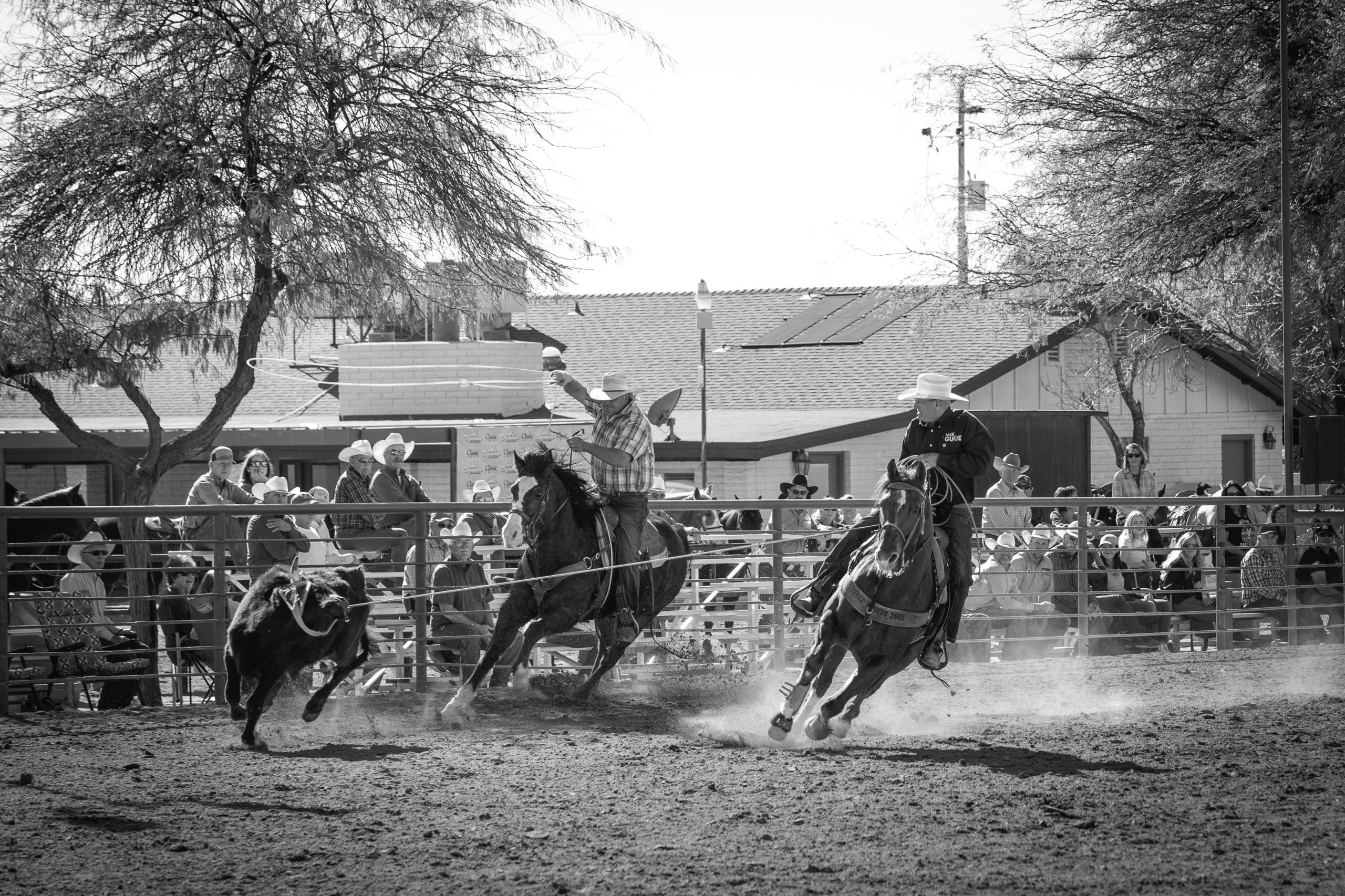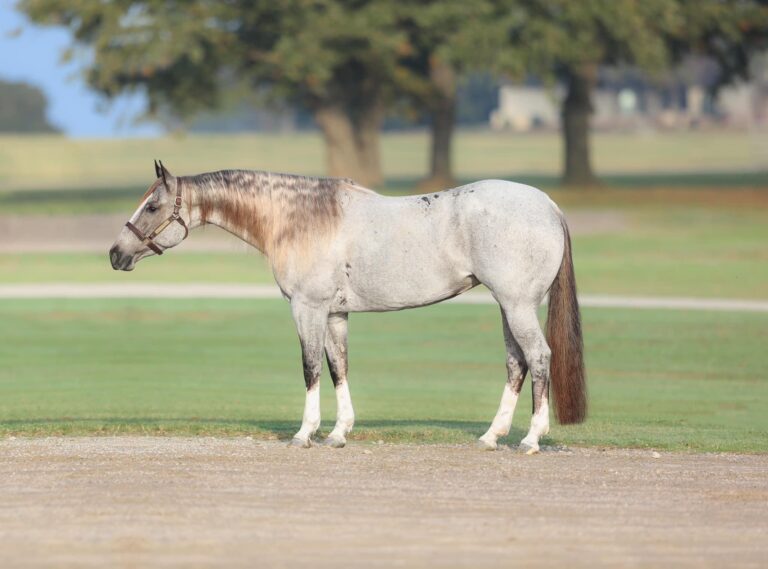In countless ways, the Baby Boomer generation is the lifeblood of recreational team roping. A generation defined by their significant contributions to the economy, now—having reached their retirement years—many Baby Boomers, aging from 57 to 75, are hitting their team roping stride as they reap the rewards of successful careers by investing their hard-earned dollars and time in good horses, the practice pen and all their favorite jackpots.
Paradoxically, what also accompanies these golden years are the aches and pains of aging. Cartilage that once allowed for ropers to swing a leg up or throw a powerful loop ceases to exist between joints and bones or injuries sustained in younger years make their true mark known and demand the body quit anything that might aggravate them.
Often, it is exactly at that point—when ropers are faced with the harsh reality that there’s a limited number of runs left—that they seek medical solutions and are regularly told their only option is surgery. And while surgery is certainly worth consideration and research and may, in fact, be just that—the only option—it turns out there may be other options, too.
The Treatment
Rachel O’Grady is the president and founder of MSK GUIDE—an acronym for Musculoskeletal Guided Ultrasound Injection & Diagnostic Experts—a regenerative therapy practice in Phoenix, Arizona, that uses ultrasound technology to identify and address the source of pain with pinpoint precision.
“Ultrasound diagnostics has always been my specialty,” O’Grady explained. “But the application for musculoskeletal injuries is what I homed in on because that’s just where my passion was—looking at the moving parts; the orthopedic injuries.”
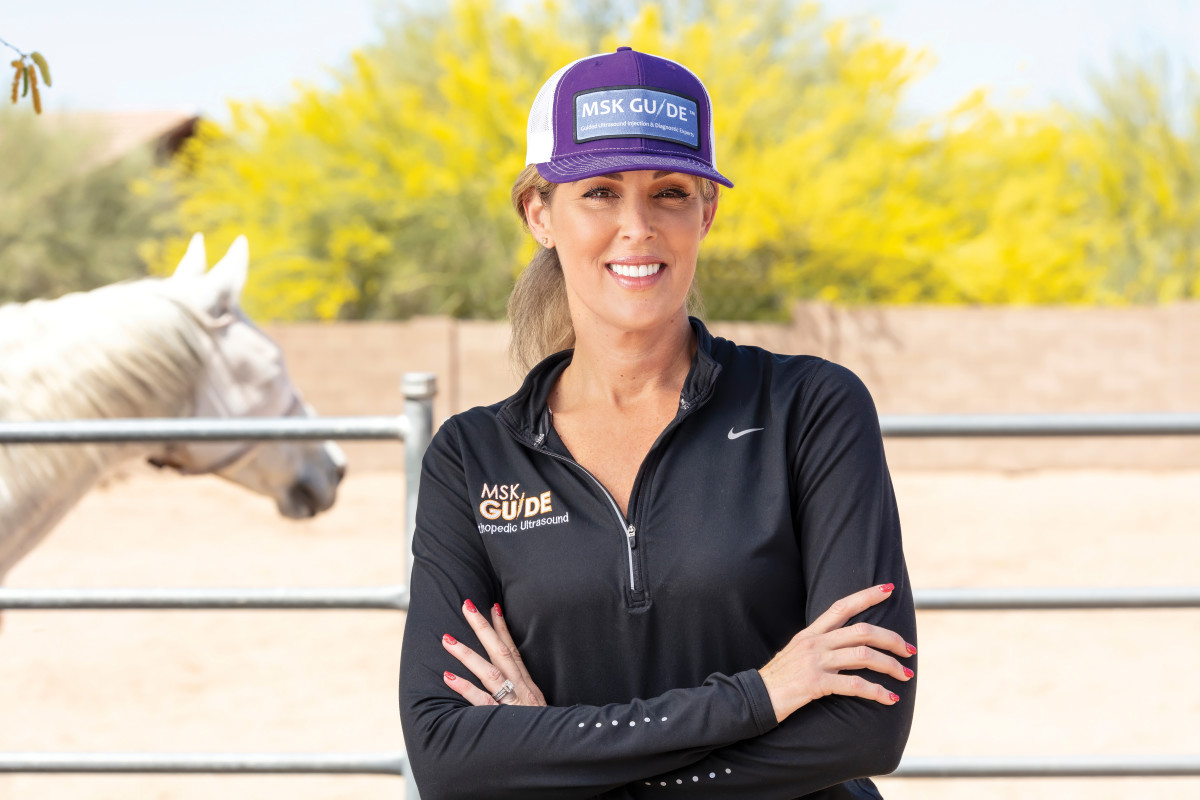
Courtesy MSk Guide/Olie Moss
As a horsewoman, O’Grady kept her horse at a barn in Cave Creek and met the influx of ropers each winter, which inspired her to take a clinic with Mike Beers, where she ended up meeting her future husband, Tom, a South Dakota rancher. It wasn’t long before O’Grady’s skillset became valued in the community.
“I met my husband who came to practice with Mike one day, and he’d say, ‘You know, Wallace has bad knees.’ And I’d say, ‘Tell him to come over and I’ll take a look at them.’ And then it just escalated from there. That’s where my focus has been, basically, on the horse community.”
As a kid, O’Grady suffered a terrifying bout with Guillain-Barre syndrome, which temporarily paralyzed her within weeks of its onset, so she understands fully the trauma of limited mobility.
“I have a great passion for helping the ranchers and farmers, because I always felt like this community was extremely underappreciated and what really goes on, like in the real life of a rancher. Just how much work is involved and how much of a sacrifice they make with their physical body. And they don’t even complain about it and don’t want any credit. Then, they go to do what they love to do, and they’re held back because they’re in pain. If I could ever have a hand in helping this particular group stay active and get to actually enjoy life without dealing with these aches and pains, that’s really what drives me.”
Today, O’Grady estimates that 99% of her patients employ a rope either in their professional or recreational endeavors. Many make appointments while they’re in Arizona for the winter or are traveling through, but many have traveled from across the country to Phoenix for the procedure, too, which is minimally invasive and can be completed in about 30 minutes.
“It can go longer, depending on if there’s multiple joints,” O’Grady said, “but the injection process is nothing more than you would have with a steroid injection of the same kind. One injection, no sedation. You don’t need a driver. You come in and usually walk out feeling better because, when the amnio goes in, it’s like a wash out. Sometimes, it’s like taking a fire hose and just blowing off the surface of the asphalt. A lot of the debris that coagulates in there from the osteoarthritis, when the amnio goes in, it just washes that away way initially.”
O’Grady is quick to point out that her injections are not STEM cell treatments. Rather, the gains to be made exist in the fact that a patient, in under one hour, can receive ultrasound-guided, regenerative treatment to the pain source with the greatest accuracy possible.
“It’s the best thing that you can do through a syringe.” O’Grady posited.
Success Stories
Wallace Townsend, 70, is an avid roper.
“I was having a lot of trouble with my knee,” he said. “It hurt me to ride, hurt me to walk. I couldn’t walk anywhere. I, actually, was getting on my horse on the right side all the time because I couldn’t bend my knee.”
Originally from Oklahoma, Townsend was a service manager for a John Deere dealership until 1995, when he went to work for himself running cows, baling hay and doing all the hard work that goes between. Then, in 2012, at 62, he’d had enough of Oklahoma’s winters.
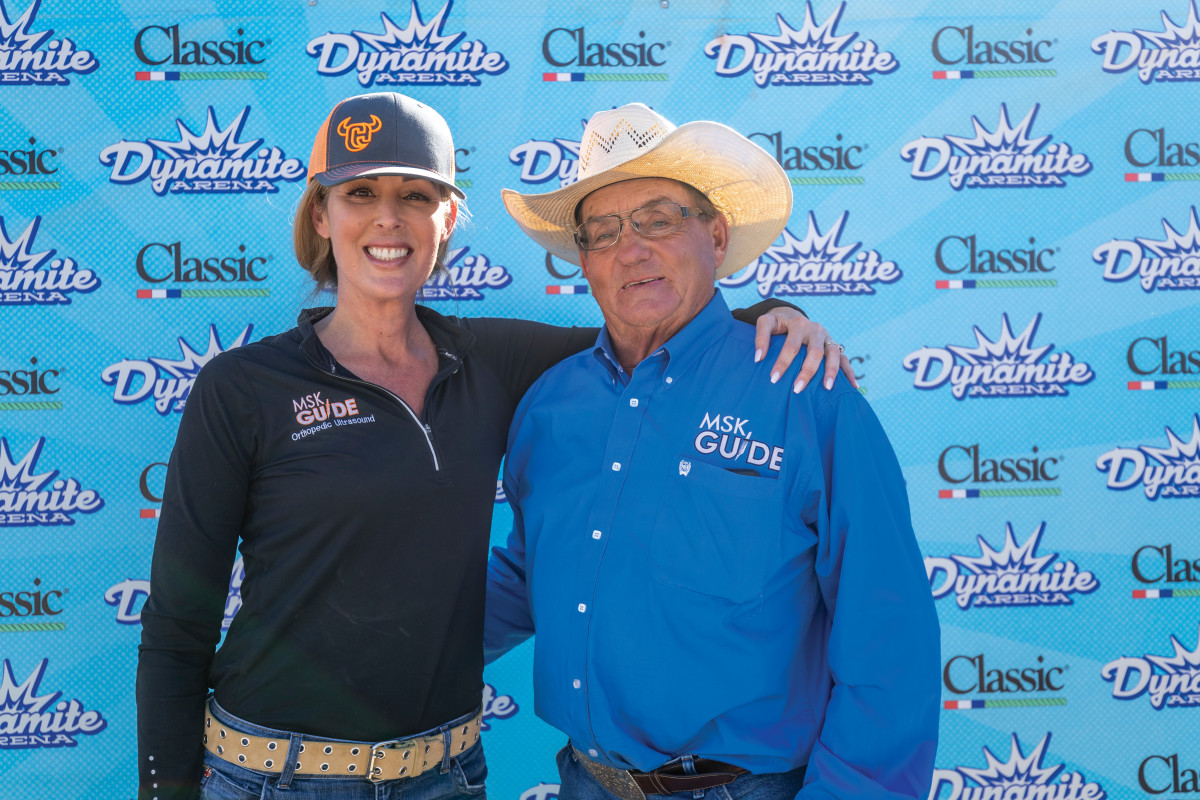
Courtesy MSk Guide/Olie Moss
“I’d worked since I was seven years old,” he said. “I wanted to get out of the cold and the feeding cows. I’ve been here since, so we rope all winter, you know, about six months, seven months a year.”
When it came time to do something about his knees, Townsend, who’d already spoke with O’Grady at the recommendation of her husband.
“I knew I had to have something done,” Townsend said. “I was gonna have to have it cut open, so I was ready to try anything. And, after talking to Rachel about the product that they use, she made a believer out of me.
“She said, ‘Well, I think I can help you out. Your knee’s in pretty bad shape. It’s bone to bone and it’s got arthritis. And you got this tear in it.’ So anyway, in the next three or four days, they injected my knee, and they took about 20 or 30 cc of bloody fluid out of it, which gave me instant relief. And probably three or four weeks after that, I started [to realize] a pretty great improvement in my knee.”
Bone-to-bone contact in the knees was also having a painful effect on Rick Steed.
“I went to the two best doctors up here,” said the 67-year-old roper from Thatcher, Utah. “They said, ‘You gotta have a new knee.’ I couldn’t walk. I couldn’t walk 20 feet, it hurt so bad. I had to buy a scooter to even go feed my horses and to go enter the ropings.”
Steed had watched his wife endure a botched knee replacement that required a re-replacement after an entire year of weekly physical therapy appointments and consistent pain.
“Getting a new knee was not an option for me,” explained the aerospace industry veteran and retired rancher. “I was going to do anything [but that].”
At Townsend’s recommendation, Steed attended a seminar about the procedure and was assured that, despite the severity of his knee’s condition, he would likely experience an improvement with the treatment.
“I got the shot. And it was three weeks to the day. I woke up in the middle of the night and I told my wife, I said, ‘Heck, my knee don’t even hurt anymore. I think I can walk.’ It’s going on two years now and I’m still good.”
For South Dakota’s JB Lord—the Badlands Circuit’s 14-time gold buckle winner in team roping, steer wrestling and the all-around, and father to NFR team roper Levi and National Finals hopeful Eli (at press time, he was ranked 15th in the steer wrestling)—it was his shoulders that had rendered him unfit to compete, particularly in the steer wrestling.
“I hurt my shoulders in 2014,” said the now 61-year-old. “Both of them in the same year. My roping wasn’t as good, and I had to quit bulldogging. I had pain in my shoulders every day and couldn’t swing my rope the way I wanted to.”
Lord ran into Tom O’Grady at the bank, and Lord scheduled a flight to Phoenix for an appointment.
“I flew down there and got them injected and I could tell within a couple of weeks that I didn’t have as much pain,” Lord recalled. “And, over the years, from then until now, I’m almost back to roping at like 100%.”
It’s been a welcome change for Lord, who had already put other therapies to the test.
“I was hoping it would relieve the pain because they really bothered me,” Lord admitted. “I went to Colorado, to some guy in Denver. I think it’s called prolotherapy and, I mean, that is so painful to have done, and I couldn’t tell that it did anything. I had about four injections like that. I went down there about four different times, and I couldn’t really tell that they got any better and it was really painful and pretty expensive to do.”
Conversely, Lord, who estimates he was treated by O’Grady in 2017, hasn’t needed to return to Phoenix for treatment.
“I haven’t been back,” he said. “She injected them both in a couple different places, I think, but, no, I haven’t been back. I’ve got a hip that’s bothering me now, and I’m thinking of going down there and having that injected.”
Silver Bullet?
While the MSK GUIDE treatment provides an attractive solution to the pain many ropers experience, not Townsend, Steed, Lord or even O’Grady herself are willing to guarantee its efficacy for everyone.
In addition to getting his shoulders injected, Lord also maintains a steady workout regimen, which he believes has played an important role in his recovery. For Townsend and Steed, their knees haven’t miraculously returned to a youthful state—it’s important to remember that aging is not reversible, though pain can be—but they’ve improved enough to enjoy a lifestyle they love.
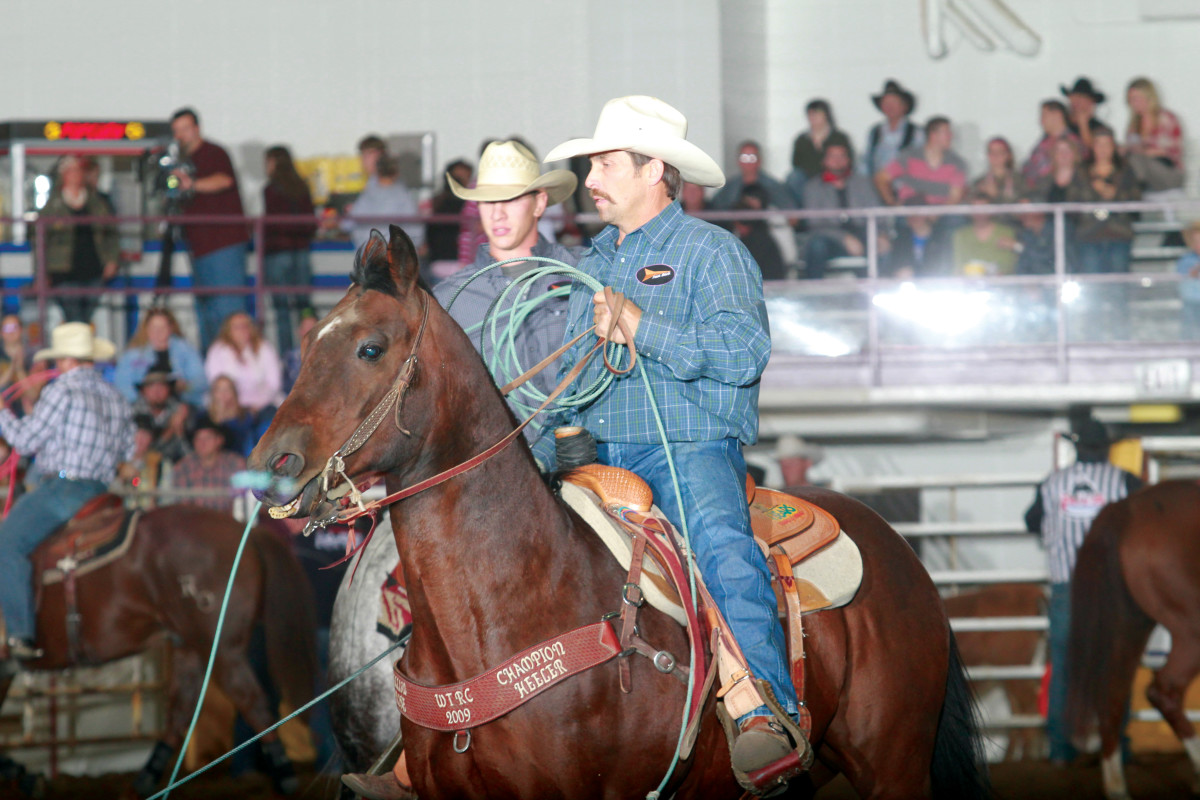
TRJ file photo
“It’s not a hundred percent,” Townsend said, “but it’s a hundred percent better than it was before.”
“We can’t say that everybody’s going to get 100% better,” O’Grady explained. “There’s about 15% that just don’t get better. They’re just too far gone for various reasons, and we’re doing our own clinical study to determine why that is.”
That’s a category that Colorado’s Lory Merritt, 67, falls into.
“I [got] both knees treated with them, but it did not work for some reason,” he said. “I think, once you get to a certain point, there is no choice but to get total joint replacement.”
Merritt had surgery on his knees at Phoenix Spine and Joint on May 6, 2021, and published his recovery on social media.
“It’s called ‘Minimally Invasive Total Joint Replacement,’” he explained. “Many orthopedic centers do not offer it, but I walked out that day (no walker, etc.), never took a pain pill other than Tylenol, was horseback in one week, roping live cattle at 4 weeks and competing again. They didn’t cut through tendons, ligaments or muscles and they use 3D technology to fit the joint replacement exactly. Traditional total joint replacements don’t have these fast results. My wife posted my recovery on Facebook, and it has had thousands of hits.”
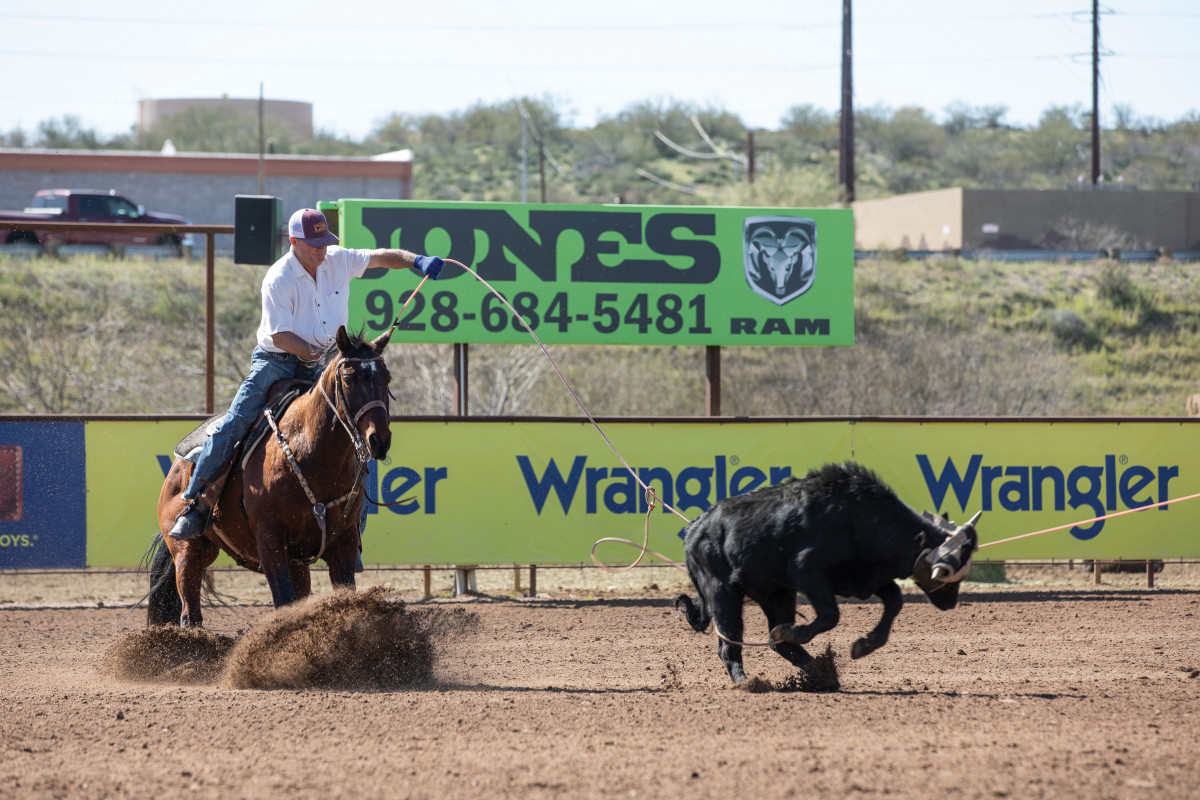
Kari deCastro Photo
Ropers Have Options
Merritt’s experience is a reminder that medical procedures and technology are advancing daily. Faced with the need for a solution, folks should be rigorous in their search for their own best option.
For many, MSK GUIDE may be—and has been—that option. It can provide some immediate relief, but patients consistently experience the real effects of the treatment a few weeks after the procedure. It’s not a silver bullet, but it’s not snake oil either.
“Everybody’s been real happy with the way Rachel does stuff,” said Townsend, who estimates he knows 20–25 friends who’ve gone to MSK GUIDE. “With how professional she is and everything. … The thing about Rachel is she’s pretty honest. She don’t try to do something if she don’t think it’ll help you. So, you know, that means a lot to a guy having to pay for it out of his pocket.”
As O’Grady emphasizes, there are a lot of treatments available for pain, but if they don’t offer the precision that her practice does, then the problem won’t be solved precisely.
“That’s our secret sauce,” she affirmed. “We can say that we will 100% place it where it needs to be.”




